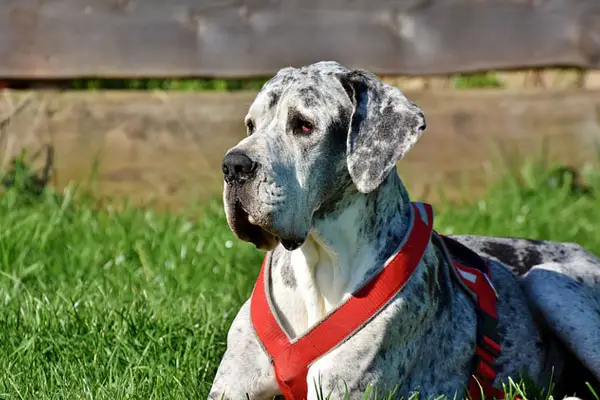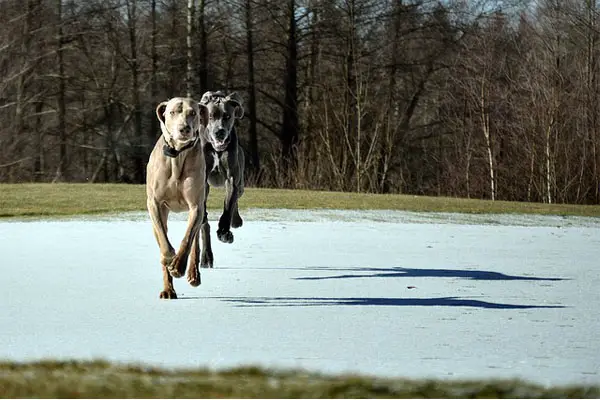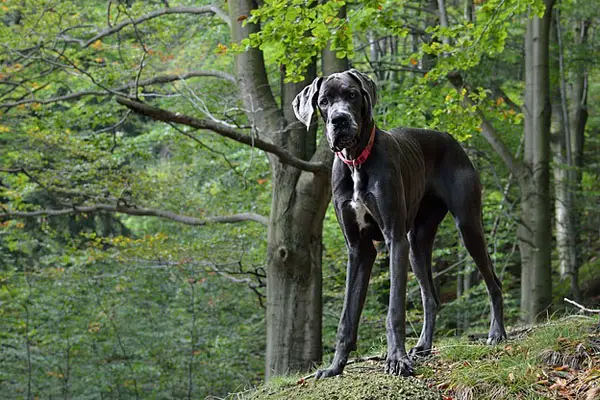Great Danes are known for their tall stature that screams elegance and nobility. However, even if they do look imposing, they are one of the best-natured dogs you’d find. Even if a Great Dane is large and intimidating, Great Danes are sweet, loving, and gentle; hence, why they are also called Gentle Giants.
Because of this, it’s no wonder that Great Danes are now one of the most popular dog breeds. They are sociable, love to be petted, and even have some lapdog tendencies. If you appreciate a big baby for a companion, then the Great Dane is undoubtedly that.

Great Dane Statistics
| Dog Breed Group | Working |
| Breed Size | Giant |
| Height | 30-32 inches (male); 28-30 inches (female) |
| Weight | 140-175 pounds (male); 110-140 pounds (female) |
| Lifespan | 7-10 years |
Great Dane Ratings
| Energy level | |
| Exercise needs | |
| Requires attention | |
| Playfulness | |
| Trainability | |
| Shedding | |
| Grooming | |
| Friendly with family | |
| Friendly with kids | |
| Friendly with strangers | |
| Friendly with other dogs | |
| Prey Drive |
Great Dane History
Great Danes are one of the pure dog breeds believed to be centuries old as historical evidence suggests. Drawings of dogs resembling the Great Danes are found in Egyptian and Babylonian artifacts way back in the 2000 and 3000 BC.
They were originally called Boar Hounds because hunting boars was their purpose. Because of this, their ears were usually cut to prevent boars from tearing them.
By the 1600s, the Great Danes slowly left the hunting grounds. German breeders gradually refined the breed into a well-balanced, good-natured, and elegant dog.
German nobles adored them and kept them in their homes. They were named Chamber Dogs as they were pampered and even wore collars, living a sweet and elegant lifestyle.
It was only in the 1700s when the name Great Dane rose. This was given by a French Naturalist who traveled to Denmark and saw a version of Boar Hound that was slimmer. He called this dog the Grand Danois, which eventually became the Great Dane (though the breed didn’t develop in Denmark).
In the 1800s, refinement of the German nobles continued refining the breeds. They paid attention to the dog’s temperaments and adjusted it from being ferocious and aggressive, to a more gentle one.
Great Dane Temperament
Great Danes are best described as friendly, gentle, and dependable dog breeds. Even with their tall and noble stature, they are loving dog breeds who crave human companionship.
Great Danes only need minimal exercise. However, due to their size, they do need a lot of space. They won’t do well in small apartments as they would feel cramped up. Also, they hate being left alone and can get lonely.
When it comes to strangers, the Great Dane’s attitude varies. Some are territorial and protective, while most are very friendly and welcoming. However, whichever the two traits, they won’t fail to bark and tell you there’s a visitor at your door.
If you have kids, you also won’t have to worry about having Great Danes. Although large, they make excellent playmates. Added to that, they also know how to move with caution when it comes to small kids as they are highly intelligent.
However, the Great Dane’s gentle temperament doesn’t usually come out naturally. Without proper training, they can be bossy, dominant, and pushy. If you want to raise a disciplined Great Dane, they need training.
It is also essential to remember that Great Danes are sensitive, and training should be fun and cheerful. Being harsh doesn’t help and will only break trust. Besides, these dogs are straightforward to train.

Great Dane Care Requirements
- Nutrition: Great Dane is a large dog breed that requires a consistent and well-balanced diet. It doesn’t matter if you’ll feed them dog food or raw dog diet. What’s important is that it should be of high-quality. Protein is an essential part of their meal, but it should also contain fats for proper development. Keep protein levels to up to 24%, and fat levels should be between 12-14% for proper growth. You can also consult your vet for additional guidance regarding caloric intake depending on your Great Danes daily activity as well.
- Grooming: Great Dane has a short and smooth coat that sheds seasonally. However, shedding is not too much -weekly brushing will help to decrease the shedding. But if it’s shedding season, then daily brushing would be better. Since they also don’t need a lot of exercise, frequent baths are not necessary unless your Great Dane becomes too messy. Bathing him a few times in a year will do. Check the nails and trim them too, just like any other dog breeds. This will help prevent your Great Dane from the pain.
- Exercise: Great Danes are excellent indoor family dogs. However, as they are huge dogs, they need daily exercise to keep their muscles strong and protect their joints too. About 30-60 minutes of exercise will do the job. Usually, this can be in the form of walking or free play. You can also do activities that will mentally stimulate the Great Dane’s mind. Just remember not to over-exercise. This dog breed is not the active type and gets tired quickly after 30 minutes of walking. Other than walking, you can also play games such as fetch, give him toys, or allow him to socialize with other dogs in the house.
- Health: Bloating is the number one reason for this. Severe complications of bloating can be prevented by surgery, but if you don’t want that, you can research more regarding the symptoms of the condition and how you can prevent it. Other common health issues Great Dane may suffer from are eye diseases, heart diseases, hypothyroidism, and hip dysplasia. Great Danes sadly have a short life expectancy. That’s why it’s necessary to keep their health optimal so they can avoid any health problems mentioned. It’s also best to take your dog to regular check-ups or take him to some tests to rule out any medical conditions.
- Lifespan: The life expectancy of Great Danes is 7-10 years.

Famous Great Danes
- Scooby-Doo: The famous dog best friend of Shaggy, a member of the Scooby-Doo Gang is a Great Dane; he also represents similar traits such as being a tremendous eater and a scaredy-cat (though he’s a dog)
- Marmaduke: Another fictional Great Dane of the Winslow family from the comic strip Marmaduke
- Einstein: The Great Dane from the movie Oliver and Company
- Duke and Turk: Family dogs from the movie The Swiss Family Robinson
- Zeus: Was named as the tallest dog in the Guinness Book of World Records
- Juliana: The Great Dane awarded with two Blue Cross Medals for diffusing a bomb by peeing on it, and alerting authorities about a fire three years later
- Just Nuisance: The only dog officially listed in the Navy
Fun Facts About Great Danes
- Great Danes were originally bred to hunt boars.
- They have been around for centuries; historical evidence suggests that they’ve been around way back 3500 and 5000 BC.
- Great Danes have short lifespans.
- They are popular cartoon dogs.
- They are known as “Gentle Giants.”
- It was believed that they could ward off ghosts and evil spirits, which is only right that Scooby-Doo was a Great Dane.
- Great Dane is the official state dog of Pennsylvania.
- They grow very fast, from one pound to a hundred in just six months.
- There was a Great Dane who escaped with a goat in Dallas, 2010.
